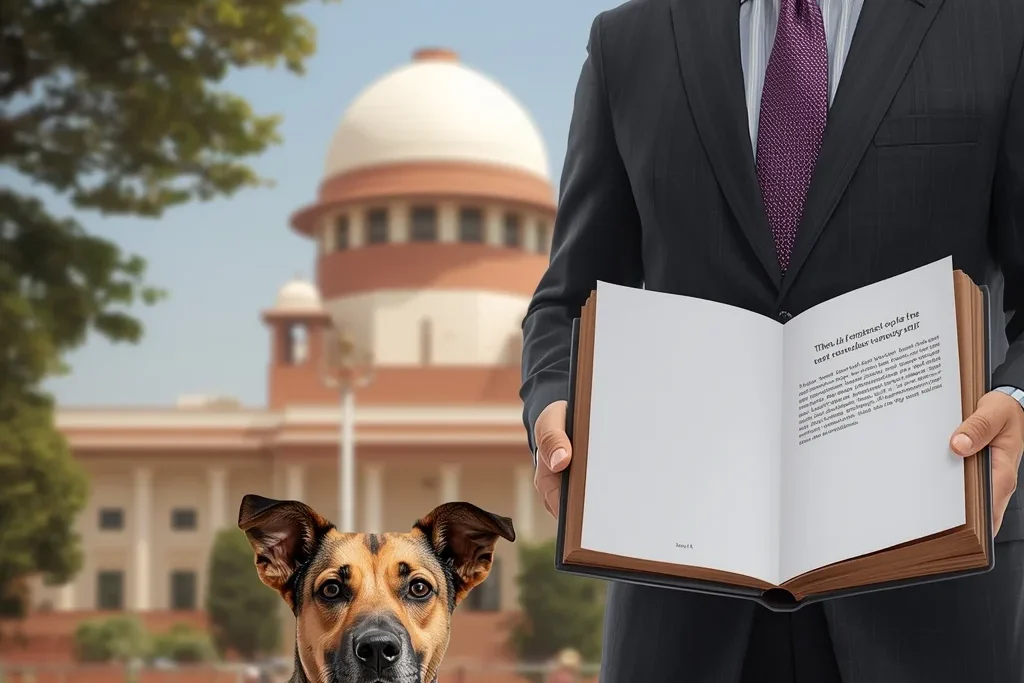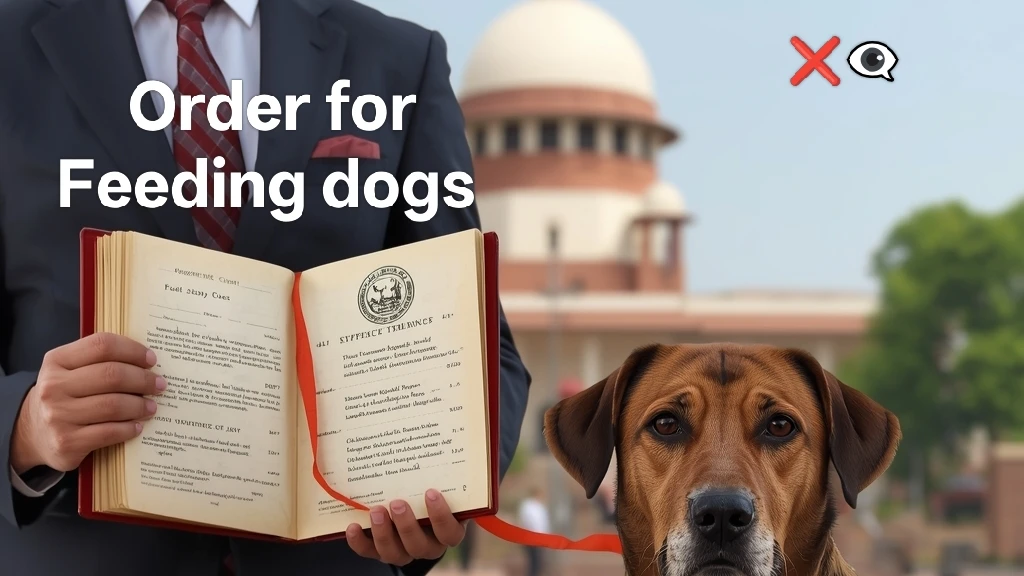Introduction to Feeding Rules
In current years, the problem of feeding stray dogs in public places — specially puppies — has sparked huge public debate in India. With developing incidents of stray dog bites, contrasting with developing reputation of animal welfare, the Supreme Court Order on Feeding Stray Dogs has turn out to be one of the maximum cited jail tendencies within the america.
This landmark preference wants to balance compassion for animals with the protection and cleanliness of public regions, specially in government and domestic regions.
The Supreme Court guidelines for animal lovers highlight that feeding stray puppies is not an offence, however it have to be finished responsibly and internal regulated areas.
With the resource of manner of introducing mounted stray dog feeding rules in India, the courtroom docket docket docket seeks to ensure humane treatment of animals on the equal time as retaining public order and fitness necessities.
What Is the Supreme Court Order on Feeding Stray Dogs?

The Supreme Court Order on Feeding Stray Dogs directs america government, municipalities, and welfare our our bodies to create specific feeding zones for stray animals.
The courtroom emphasises that every municipality and panchayat need to discover relaxed spots wherein residents and animal enthusiasts can feed strays with out obstructing public movement or causing war.
This directive moreover recognizes the emotional bond many citizens percent with animals, specially on the town and semi-metropolis settings. Even as selling compassion, it simultaneously ensures obligation, setting a smooth form for feeding sports sports activities in public places and place of business premises.
Also Read —IT Rules 2025 and AI Governance Explained
Can We Feed Stray Dogs in Public Places?
Sure — but below first-rate situations. The courtroom’s ruling clarifies that feeding stray dogs in public places want to be jail handiest in well-known or wonderful zones.
Feeding animals in busy marketplaces, close to schools, or inner government place of work premises with out permission may additionally furthermore furthermore bring about disputes or safety risks.
The idea isn’t to prohibit feeding but to channel it into more at ease practices. As an example, many resident welfare establishments (rwas) are in fact participating with community animal welfare officials to select out appropriate spots internal their neighbourhoods.
This initiative no longer incredible safeguards public consolation however furthermore ensures that animal rights and welfare laws are legitimate.
Where Can Stray Dogs Be Fed Legally?
Following the Supreme Court guidelines for animal lovers, each network authority should allocate precise regions — together with parks, community corners, or an lousy lot lots a good deal much less-crowded pathways — as right feeding zones.
Feeding outdoor the ones spots can enchantment to warnings or consequences relying on community municipal suggestions. The ones tips inspire residents to coordinate with nearby veterinarians or animal ngos even as installing feeding drives.
| Place | Allowed | Note |
|---|---|---|
| Designated zones | ✅ Yes | Approved by local authorities. |
| Residential areas | ✅ Yes | With RWA or civic permission. |
| Public parks | ✅ Yes | In fixed, clean spots only. |
| Office premises | ⚠️ Limited | Only in approved corners. |
| Roads/markets | ❌ No | Causes obstruction, unsafe. |
| Schools/hospitals | ❌ No | Health and safety concerns. |
Such collaboration guarantees hygiene, vaccination, and sterilization — all a part of India’s large animal rights and welfare laws framework.
Suggested post—Get higher pension with quick online Apply
What Are the Rules for Feeding Stray Dogs in India?
The stray dog feeding rules in India have advanced from numerous judicial interpretations, authorities circulars, and animal welfare acts. The Supreme Court Order on Feeding Stray Dogs has reaffirmed the following mind:
- Specific feeding areas: municipal our our our our our bodies need to mark comfortable, non-obstructive feeding zones.
- Community obligation: community residents and feeders want to keep cleanliness and discipline at the ones spots.
- No harassment of feeders: residents who feed puppies in right regions are covered below animal rights and welfare laws.
- Public safety first: feeding want to not stand up in crowded or sensitive zones wherein dog-human conflicts can also moreover moreover additionally moreover rise up.
- Sterilization and vaccination: feeders should coordinate with ngos to assist manipulate stray populations humanely.
The ones Supreme Court guidelines for animal lovers highlight the steadiness among empathy and obligation — ensuring that kindness does not compromise safety.
Is Feeding Stray Dogs Allowed in Offices?

The courtroom docket docket has especially addressed problems about feeding dogs in government place of job premises.
Personnel or net page traffic have to refrain from feeding animals inner jogging zones, corridors, or constructing entrances. But, if the place of business compound has an open and comfortable corner, authorities can designate a feeding location there.
The Supreme Court Order on Feeding Stray Dogs clarifies that feeding inner administrative center premises with out authorization can also moreover cause sanitation problems and inconvenience.
Therefore, particular spots outdoor the principle operational place are the correct answer — maintaining each compassion and professionalism.
What Are the Penalties for Feeding Stray Dogs in Restricted Areas?
While no direct countrywide penalty exists for feeding stray animals, municipal government have powers to trouble warnings or fines for violating sanitation or protection guidelines.
As an example, feeding puppies near waste containers or public roads can also furthermore attraction to outcomes underneath close by bylaws associated with public nuisance.
Here’s a short and clear version focused only on Offence Type & Penalties 👇
| Offence Type (Related to Feeding Stray Dogs) | Penalty / Action |
|---|---|
| Feeding in restricted / prohibited zones | Local municipal fine (approx. ₹500–₹2000) |
| Creating public nuisance during feeding | Small fine (up to ₹200) under public nuisance rules |
| Blocking roads or causing sanitation issues | Fine under municipal laws; repeated violations can increase penalty |
| Disobeying civic guidelines for feeding spots | Warning → higher fines if continued |
| Harassing / harming feeders or animals | Fine or imprisonment up to 3 months under animal protection laws |
However, harassing or physical harming feeders or animals is a punishable offence underneath animal rights and welfare laws, together with the prevention of cruelty to animals act, 1960.
The Supreme Court guidelines for animal lovers pressure that compassion should be advocated — but internal defined and cozy boundaries.
What Are the Supreme Court Guidelines for Animal Lovers?
The court’s hints increase past feeding practices. They underline the ethical responsibility of each citizen to recognize and defend animals. The Supreme Court guidelines for animal lovers encompass:
- Selling sterilization and vaccination drives.
- Feeding terrific in accepted regions.
- Reporting cruelty or abuse to government.
- Supporting interest campaigns on responsible feeding.
Those steps align with India’s constitutional recognition of animal welfare as a part of citizens’ essential duties beneath article 51a(g). The Supreme Court Order on Feeding Stray Dogs consequently integrates compassion into civic behaviour, framing it as a shared social duty.
How Does the Order Affect Animal Rights in India?

The ruling strengthens the us of america’s jail framework on animal rights and welfare laws. It reinforces that animals, being dwelling beings, have the proper to exist with out vain struggling.
The judgment builds on in advance choices together with animal welfare board of India vs. A. Nagaraja (2014), which superior the concept of animal dignity.
Via formally recognising regulated feeding zones, the Supreme Court Order on Feeding Stray Dogs guarantees that each animals and those can coexist harmoniously — reducing war at the same time as advancing compassion.
What Is the Purpose of Designated Feeding Zones?
The appearance of targeted zones enables address a couple of troubles. First, it reduces stray movement in crowded regions. Second, it lets in nearby authorities to music and display animals for sterilization and vaccination. Zero.33, it continues feeding sports activities clean and prepared, assisting hygiene necessities.
Those zones furthermore make it much less difficult to position into impact stray dog feeding rules in India, giving every feeders and non-feeders a revel in of readability. The give up end result is a established, humane device that respects public consolation and animal welfare similarly.
What Is the Role of Municipal Authorities?
Municipal our our bodies preserve a vital feature in implementing the Supreme Court guidelines for animal lovers. Their responsibilities encompass:
- Figuring out and staining comfy feeding spots.
- Coordinating with ngos for sterilization programs.
- Ensuring right waste disposal after feeding.
- Training the general public on responsible feeding behavior.
Their energetic participation bridges the gap amongst prison orders and floor fact, turning the Supreme Court Order on Feeding Stray Dogs into a practical, sustainable insurance.
How Do Animal Welfare Organizations Participate?
Animal ngos and welfare corporations are precious to implementing animal rights and welfare laws. They behavior attention durations, prepare feeding applications, and train volunteers.
Many ngos furthermore hold feeding schedules, making sure that stray puppies gather food without growing overcrowded or unhygienic conditions.
The collaboration amongst animal fans and government exemplifies how hooked up compassion can function internal civic limits — a middle reason within the again of the stray dog feeding rules in India.
How Does the Order Balance Compassion and Safety?
The courtroom docket’s ruling is designed to prevent battle amongst feeders and non-feeders. On one hand, it recognises the emotional and moral stress to attend to stray animals. On the other, it acknowledges public problems over protection, hygiene, and noise.
Here’s a short and clear table focused only on Aspects and Safety Measures 👇
| Aspects | Safety Measures |
|---|---|
| Feeding Locations | Only allowed in designated safe zones, away from crowded or restricted areas |
| Public Hygiene | Feeders must clean the area after feeding to prevent sanitation issues |
| Stray Behaviour | Regular feeding helps reduce aggression by ensuring dogs are not hungry |
| Vaccination & Sterilization | Coordination with NGOs for sterilization and vaccination to control population |
| Public Interaction | Awareness programs to educate citizens and prevent feeder–non-feeder conflicts |
This stability is relevant to the Supreme Court guidelines for animal lovers. It transforms feeding from an informal interest right right into a regulated civic motion, giving each citizens and government organizations a smooth code of behavior.
What Happens if Citizens or RWAs Violate the Order?
If resident welfare institutions (rwas) restriction all feeding, they may violate the Supreme Court Order on Feeding Stray Dogs. Conversely, if feeders forget about about high quality hints, they will be penalized under nearby criminal hints.
The court docket’s technique promotes talk in preference to punishment. Authorities encourage community conferences to determine collectively handy feeding times and places, turning capability disputes into collaborative arrangements.
How Do Animal Rights Connect to Human Rights?
The animal rights and welfare laws in India often intersect with human rights through the lens of compassion and coexistence. Article 21 of the charter guarantees the proper to lifestyles, which the Supreme Court has interpreted to embody living in a healthful and harmonious surroundings — one that furthermore respects animal lifestyles.
By means of the usage of framing feeding policies beneath this principle, the Supreme Court Order on Feeding Stray Dogs enhances each ecological and ethical integrity. It reminds citizens that empathy inside the course of animals is an extension of humanity itself.
What Impact Will the Supreme Court Order Have on Society?
Ultimately, the courtroom docket docket’s direction is predicted to reduce stray aggression and decorate sanitation necessities.
With organized feeding, strays may be vaccinated and sterilized extra successfully. Furthermore, set up feeding drives can also moreover furthermore lower the tremendous sort of canine-chew incidents with the useful useful resource of reducing hunger and territorial behaviour.
| Aspects | Impact on Society |
|---|---|
| Animal Welfare | Promotes humane treatment and protection of stray dogs |
| Public Safety | Reduces stray aggression and dog-bite incidents through organized feeding |
| Hygiene Standards | Improves cleanliness with regulated feeding zones |
| Community Harmony | Encourages cooperation between animal lovers and residents |
| Legal Awareness | Increases understanding of animal rights and civic responsibilities |
The order moreover nurtures civic obligation, urging residents to view feeding as a disciplined, lawful, and compassionate act aligned with the stray dog feeding rules in India.
How Do These Rules Reflect India’s Ethical Vision?
India’s cultural and religious roots recommend kindness inside the route of all residing beings. The Supreme Court guidelines for animal lovers deliver a boost to this timeless charge internal present day governance. Through installed compassion, the u . S . Gadgets a precedent for coexistence that special global locations can emulate.
Via institutionalizing empathy thru regulation, the Supreme Court Order on Feeding Stray Dogs becomes more than a directive — it will become a contemplated photo of India’s evolving moral sense of right and wrong.
FAQ related to Feeding Street dogs in India
1. Is it legal to feed stray dogs?
Yes, it’s legal if done responsibly and in designated safe areas approved by authorities.
2. What is Section 291 for stray dogs?
Section 291 IPC penalizes public nuisance, including feeding stray dogs in restricted or unsafe areas.
3. What is the 3-3-3 rule for dogs?
It explains dog adjustment — 3 days to relax, 3 weeks to learn, 3 months to bond.
4. Is feeding stray dogs Section 503 Act IPC?
No, Section 503 covers criminal intimidation, not feeding stray dogs or animal welfare.
5. What is the 10% rule for feeding dogs?
Treats or extra food shouldn’t exceed 10% of a dog’s daily calorie intake.
Conclusion
The Supreme Court Order on Feeding Stray Dogs represents a thoughtful aggregate of compassion and civic order. It protects the rights of animals under modern-day animal rights and welfare laws, at the identical time as making sure the safety of the general public via regulated stray dog feeding rules in India.
Feeding stray dogs in public places isn’t a rely of private discretion — it’s a tough and rapid up act guided thru way of regulation, empathy, and duty. The Supreme Court guidelines for animal lovers make one element clean: kindness inside the path of animals want to constantly pass hand in hand with reputation, discipline, and recognize for community areas.
India’s prison and ethical improvement maintains to remind residents that the real diploma of a civilized society lies in the manner it treats its maximum inclined — which incorporates the voiceless beings who percent our streets, parks, and normal lives.
Further Readings:
- Indian Privacy Laws: Safeguarding Digital Rights and Data Protection in India
- Kerala High CourtAI Guidelines for Judicial Integrity
- Google India Law Internship 2025 for Law Students in Gurgaon

